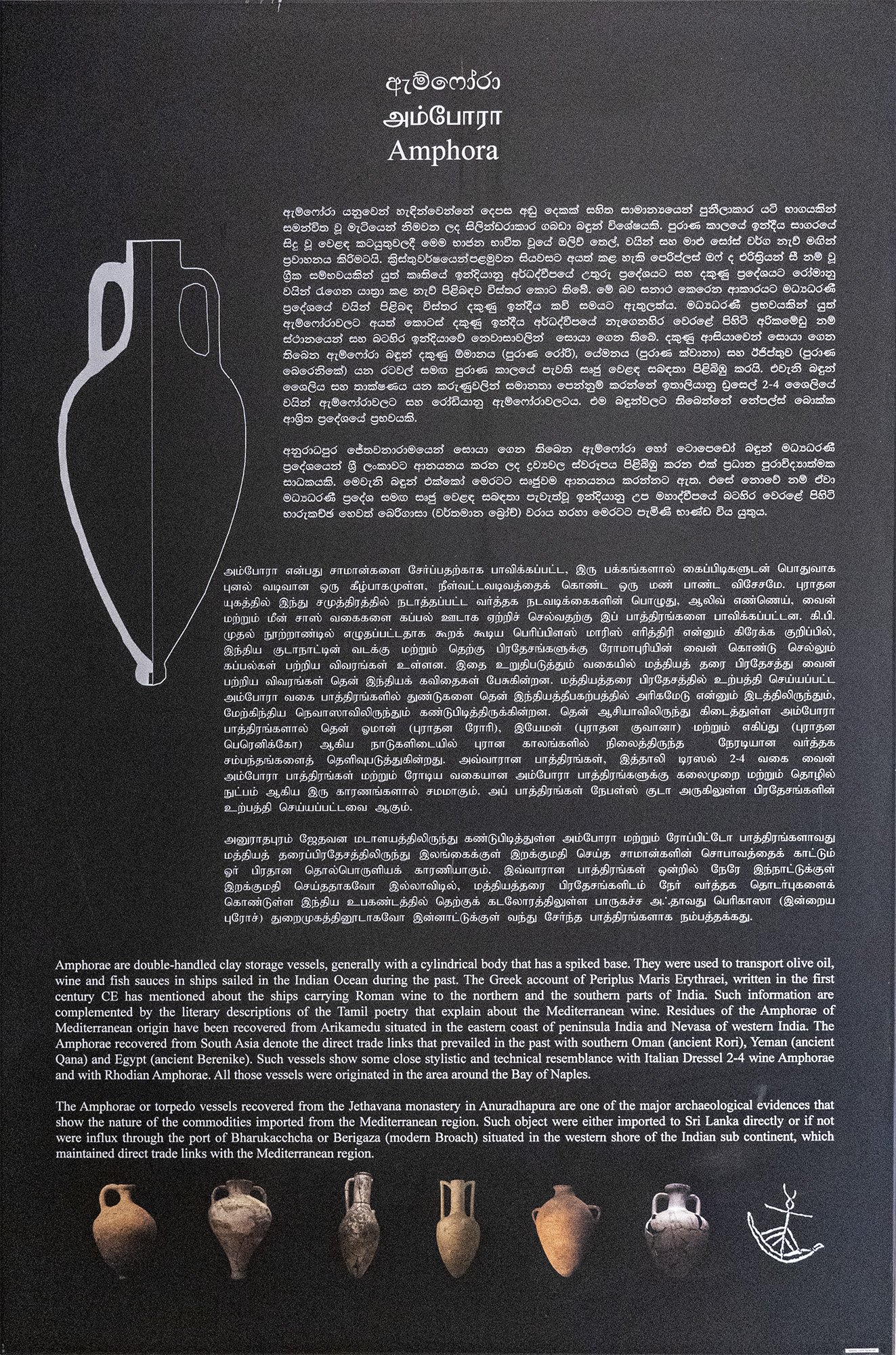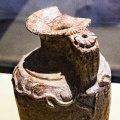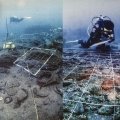Maritime Museum (Galle): photo 7
Photo 7 of 63 in Gallery: Maritime Museum (Galle)

Image title: Amphora vessels
Description of the photo
English text:
Amphorae (Amphora) are double-handled clay storage vessels, generally with a cylindrical body that has a spiked base. They were used to transport olive oil, wine and fish sauces in ships sailed in the Indian Ocean during the past. The Greek account of Periplus Maris Erythraei, written in the first century CE has mentioned about the ships carrying Roman wine to the northern and the southern parts of India. Such information are complemented by the literary descriptions of the Tamil poetry that explain about the Mediterranean wine. Residues of the Amphora of Mediterranean origin have been recovered from Arikamedu situated in the eastern coast of peninsula India and Nevasa of western India. The Amphora (Amphorae) recovered from South Asia denote the direct trade links that prevailed in the past with southern Oman (ancient Rori), Yeman (ancient Qana) and Egypt (ancient Berenike). Such vessels show some close stylistic and technical resemblance with Italian Dressel 2-4 wine Amphora and with Rhodian Amphora. All those vessels were originated in the area around the Bay of Naples.
The Amphorae or torpedo vessels recovered from the Jethavana monastery in Anuradhapura are one of the major archaeological evidences that show the nature of the commodities imported from the Mediterranean region. Such object were either imported to Sri Lanka directly or if not were influx through the port of Bharukacchcha or Berigaza (modern Broach) situated in the western shore of the Indian sub continent, which maintained direct trade links with the Mediterranean region.
Sinhala text (not proofread):
ඇම්පෝරා — ඇම්පෝරා යනුවෙන් හැඳින්වෙන්නේ දෙපස අඩු දෙකක් සහිත සාමාන්යයෙන් පුනීලාකාර යටි භාගයකින් සමන්විත වූ මැටියෙන් නිමවන ලද සිලින්ඩරාකාර ගබඩා බඳුන් විශේෂයකි. පුරාණ කාලයේ ඉන්දීය සාගරයේ සිදු වූ වෙළඳ කටයුතුවලදී මෙම භාජන භාවිත වූයේ ඔලිව් තෙල්, වයින් සහ මාළු සෝස් වර්ග නැව් මගින් ප්රවාහනය කිරීමටයි. ක්රිස්තුවර්ෂයෙන් පළමු වන සියවසට අයත් කළ හැකි පෙරිප්ලස් ඔෆ් ද එරිත්රියන් සී නම් වූ ග්රීක සම්භවයකින් යුත් කෘතියේ ඉන්දියානු අර්ධද්වීපයේ උතුරු ප්රදේශයට සහ දකුණු ප්රදේශයට රෝමානු වයින් රැගෙන යාත්රා කළ නැව් පිළිබඳව විස්තර කොට තිබේ. මේ බව සනාථ කෙරෙන ආකාරයට මධ්යධරණී ප්රදේශයේ වයින් පිළිබඳ විස්තර දකුණු ඉන්දීය කවි සමයට ඇතුලත්ය. මධ්යධරණී ප්රභවයකින් යුත් ඇල්ෆෝරා වලට අයත් කොටස් දකුණු ඉන්දීය අර්ධද්වීපයේ නැගෙනහිර වෙරළේ පිහිටි අරිකමේඩු නම් ස්ථානයෙන් සහ බටහිර ඉන්දියාවේ නෙවාසාවලින් සොයා ගෙන තිබේ. දකුණු ආසියාවෙන් සොයා ගෙන තිබෙන ඇෆෝරා බඳුන් දකුණු ඕමානය (පුරාණ රෝරි), යේමනය (පුරාණ ක්වානා) සහ ඊජිප්තුව (පුරාණ බෙරෙනිකේ) යන රටවල් සමඟ පුරාණ කාලයේ පැවති සෘජු වෙළඳ සබඳතා පිළිබිඹු කරයි. එවැනි බඳුන් ශෛලිය සහ තාක්ෂණය යන කරුණුවලින් සමානතා පෙන්නුම් කරන්නේ ඉතාලියානු ඩ්රසෙල් 2-4 ශෛලියේ වයින් ඇෆෝරා වලට සහ රෝඩියානු ඇම්පෝරාවලටය. එම බඳුන්වලට තිබෙන්නේ නේපල්ස් බොක්ක ආශ්රිත ප්රදේශයේ ප්රභවයකි.
අනුරාධපුර ජේතවනාරාමයෙන් සොයා ගෙන තිබෙන ඇම්පෝරා හෝ ටොපෙඩෝ බඳුන් මධ්යධරණී ප්රදේශයෙන් ශ්රී ලංකාවට ආනයනය කරන ලද ද්රව්යවල ස්වරූපය පිළිබිඹු කරන එක් ප්රධාන පුරාවිද්යාත්මක සාධකයකි. මෙවැනි බඳුන් එක්කෝ මෙරටට සෘ
Transcription:
æmpōrā yanuven hændinvennē depasa aḍu dekak sahita sāmānyayen punīlākāra yaṭi bhāgayakin samanvita vū mæṭiyen nimavana lada silinḍarākāra gabaḍā bandun viśēṣayaki. purāṇa kālayē indīya sāgarayē sidu vū veḷanda kaṭayutuvaladī mema bhājana bhāvita vūyē oliv tel, vayin saha māḷu sōs varga næv magin pravāhanaya kirīmaṭayi. kristuvarṣayen paḷamu vana siyavasaṭa ayat kaḷa hæki periplas of da eritriyan sī nam vū grīka sambhavayakin yut krutiyē indiyānu ardhadvīpayē uturu pradēśayaṭa saha dakuṇu pradēśayaṭa rōmānu vayin rægena yātrā kaḷa næv piḷibandava vistara koṭa tibē. mē bava sanātha kerena ākārayaṭa madhyadharaṇī pradēśayē vayin piḷibanda vistara dakuṇu indīya kavi samayaṭa ætulatya. madhyadharaṇī prabhavayakin yut ælfōrā valaṭa ayat koṭas dakuṇu indīya ardhadvīpayē nægenahira veraḷē pihiṭi arikamēḍu nam sthānayen saha baṭahira indiyāvē nevāsāvalin soyā gena tibē. dakuṇu āsiyāven soyā gena tibena æfōrā bandun dakuṇu ōmānaya (purāṇa rōri), yēmanaya (purāṇa kvānā) saha ījiptuva (purāṇa berenikē) yana raṭaval samaṅga purāṇa kālayē pævati sruju veḷanda sabandatā piḷibiḅu karayi. evæni bandun śaĩliya saha tākṣaṇaya yana karuṇuvalin samānatā pennum karannē itāliyānu ḍrasel 2-4 śaĩliyē vayin æfōrā valaṭa saha rōḍiyānu æmpōrāvalaṭaya. ema bandunvalaṭa tibennē nēpals bokka āśrita pradēśayē prabhavayaki.
anurādhapura jētavanārāmayen soyā gena tibena æmpōrā hō ṭopeḍō bandun madhyadharaṇī pradēśayen śrī laṅkāvaṭa ānayanaya karana lada dravyavala svarūpaya piḷibiḅu karana ek pradhāna purāvidyātmaka sādhakayaki. mevæni bandun ekkō meraṭaṭa sru
Transcription:
ampora yanuven handinvenne depasa adu dekak sahita samanyayen punilakara yati bhagayakin samanvita vu matiyen nimavana lada silindarakara gabada bandun visheshayaki. purana kalaye indiya sagaraye sidu vu velanda katayutuvaladi mema bhajana bhavita vuye oliv tel, vayin saha malu sos varga nav magin pravahanaya kirimatayi. kristuvarshayen palamu vana siyavasata ayat kala haki periplas of da eritriyan si nam vu grika sambhavayakin yut krutiye indiyanu ardhadvipaye uturu pradeshayata saha dakunu pradeshayata romanu vayin ragena yatra kala nav pilibandava vistara kota tibe. me bava sanatha kerena akarayata madhyadharani pradeshaye vayin pilibanda vistara dakunu indiya kavi samayata atulatya. madhyadharani prabhavayakin yut alfora valata ayat kotas dakunu indiya ardhadvipaye nagenahira verale pihiti arikamedu nam sthanayen saha batahira indiyave nevasavalin soya gena tibe. dakunu asiyaven soya gena tibena afora bandun dakunu omanaya (purana rori), yemanaya (purana kvana) saha ijiptuva (purana berenike) yana rataval samanga purana kalaye pavati sruju velanda sabandata pilibiḅu karayi. evani bandun shailiya saha takshanaya yana karunuvalin samanata pennum karanne italiyanu drasel 2-4 shailiye vayin afora valata saha rodiyanu amporavalataya. ema bandunvalata tibenne nepals bokka ashrita pradeshaye prabhavayaki.
anuradhapura jetavanaramayen soya gena tibena ampora ho topedo bandun madhyadharani pradeshayen shri lankavata anayanaya karana lada dravyavala svarupaya pilibiḅu karana ek pradhana puravidyatmaka sadhakayaki. mevani bandun ekko meratata sru
Automated translation (not verified):
An amphora is a type of cylindrical storage vessel made of clay consisting of a generally funnel-shaped lower half with two lower sides. In ancient Indian Ocean trade, these vessels were used to transport olive oil, wine and fish sauce by ship. The Periplus of the Erythrean Sea, a work of Greek origin, which can be dated to the first century AD, describes the ships that carried Roman wine to the northern and southern parts of the Indian subcontinent. This is confirmed by the description of Mediterranean wines in South Indian poetry. Fragments of alphora of Mediterranean origin have been found at Arikamedu on the east coast of the southern Indian peninsula and at Nevasa in western India. Aphora vases found in South Asia reflect direct ancient trade relations with southern Oman (ancient Rori), Yemen (ancient Quanah) and Egypt (ancient Berenice). Such vases show similarities in style and technique to Italian Dresel 2-4 style wine amphorae and to Rhodian amphorae. The vases have a provenance in the area around the Bay of Naples.
Amphora or torpedo vessels found at Anuradhapura Jethavanarama are one of the main archaeological factors that reflect the form of materials imported to Sri Lanka from the Mediterranean. Such vases are either brought to Sri Lanka
Tamil text (not proofread):
அம்போரா — அம்போரா என்பது சாமான்களை சேர்ப்பதற்காக பாவிக்கப்பட்ட, இரு பக்கங்களால் கைப்பிடிகளுடன் பொதுவாக புனல் வடிவான ஒரு கீழ்பாகமுள்ள, நீள்வட்டவடிவத்தைக் கொண்ட ஒரு மண் பாண்ட விசேசமே. புராதன யுகத்தில் இந்து சமுத்திரத்தில் நடாத்தப்பட்ட வர்த்தக நடவடிக்கைகளின் பொழுது, ஆலிவ் எண்ணெய், வைன் மற்றும் மீன் சாஸ் வகைகளை கப்பல் ஊடாக ஏற்றிச் செல்வதற்கு இப் பாத்திரங்களை பாவிக்கப்பட்டன. கி.பி. முதல் நூற்றாண்டில் எழுதப்பட்டதாக கூறக் கூடிய பெரிப்பிளஸ் மாரிஸ் எரித்திரி என்னும் கிரேக்க குறிப்பில், இந்திய குடாநாட்டின் வடக்கு மற்றும் தெற்கு பிரதேசங்களுக்கு ரோமாபுரியின் வைன் கொண்டு செல்லும் கப்பல்கள் பற்றிய விவரங்கள் உள்ளன. இதை உறுதிபடுத்தும் வகையில் மத்தியத் தரை பிரதேசத்து வைன் பற்றிய விவரங்கள் தென் இந்தியக் கவிதைகள் பேசுகின்றன. மத்தியத்தரை பிரதேசத்தில் உற்பத்தி செய்யப்பட்ட அம்போரா வகை பாத்திரங்களில் துண்டுகளை தென் இந்தியத்தீபகற்பத்தில் அரிகமேடு என்னும் இடத்திலிருந்தும், மேற்கிந்திய நெவாஸாவிலிருந்தும் கண்டுபிடித்திருக்கின்றன. தென் ஆசியாவிலிருந்து கிடைத்துள்ள அம்போரா பாத்திரங்களால் தென் ஓமான் (புராதன ரோரி), இயேமன் (புராதன குவானா) மற்றும் எகிப்து (புராதன பெரெனிக்கோ)ஆகிய நாடுகளிடையில் புரான காலங்களில் நிலைத்திருந்த நேரடியான வர்த்தக சம்பந்தங்களைத் தெளிவுபடுத்துகின்றது. அவ்வாரான பாத்திரங்கள், இத்தாலி டிரஸல் 2-4 வகை வைன் அம்போரா பாத்திரங்கள் மற்றும் ரோடிய வகையான அம்போரா பாத்திரங்களுக்கு கலைமுறை மற்றும் தொழில் நுட்பம் ஆகிய இரு காரணங்களால் சமமாகும். அப் பாத்திரங்கள் நேபள்ஸ் குடா அருகிலுள்ள பிரதேசங்களின் உற்பத்தி செய்யப்பட்டவை ஆகும்.
அனுராதபுரம் ஜேதவன மடாளயத்திலிருந்து கண்டுபிடித்துள்ள அம்போரா மற்றும் ரோப்பிட்டோ பாத்திரங்களாவது மத்தியத் தரைப்பிரதேசத்திலிருந்து இலங்கைக்குள் இறக்குமதி செய்த சாமான்களின் சொபாவத்தைக் காட்டும் ஓர் பிரதான தொல்பொருளியக் காரணியாகும். இவ்வாரான பாத்திரங்கள் ஒன்றில் நேரே இந்நாட்டுக்குள் இறக்குமதி செய்ததாகவோ இல்லாவிடில், மத்தியத்தரை பிரதேசங்களிடம் நேர் வர்த்தக தொடர்புகளைக் கொண்டுள்ள இந்திய உபகண்டத்தில் தெற்குக் கடலோரத்திலுள்ள பாருகச்ச அஃதாவது பெரிகாஸா (இன்றைய புரோச்) துறைமுகத்தினூடாகவோ இன்னாட்டுக்குள் வந்து சேர்ந்த பாத்திரங்களாக நம்பத்தக்கது.
Transcription:
ampōrā eṉpatu cāmāṉkaḷai cērppataṟkāka pāvikkappaṭṭa, iru pakkaṅkaḷāl kaippiṭikaḷuṭaṉ potuvāka puṉal vaṭivāṉa oru kīḻpākamuḷḷa, nīḷvaṭṭavaṭivattaik koṇṭa oru maṇ pāṇṭa vicēcamē. purātaṉa yukattil intu camuttirattil naṭāttappaṭṭa varttaka naṭavaṭikkaikaḷiṉ poḻutu, āliv eṇṇey, vaiṉ maṟṟum mīṉ cās vakaikaḷai kappal ūṭāka ēṟṟic celvataṟku ip pāttiraṅkaḷai pāvikkappaṭṭaṉa. ki.pi. mutal nūṟṟāṇṭil eḻutappaṭṭatāka kūṟak kūṭiya perippiḷas māris erittiri eṉṉum kirēkka kuṟippil, intiya kuṭānāṭṭiṉ vaṭakku maṟṟum teṟku piratēcaṅkaḷukku rōmāpuriyiṉ vaiṉ koṇṭu cellum kappalkaḷ paṟṟiya vivaraṅkaḷ uḷḷaṉa. itai uṟutipaṭuttum vakaiyil mattiyat tarai piratēcattu vaiṉ paṟṟiya vivaraṅkaḷ teṉ intiyak kavitaikaḷ pēcukiṉṟaṉa. mattiyattarai piratēcattil uṟpatti ceyyappaṭṭa ampōrā vakai pāttiraṅkaḷil tuṇṭukaḷai teṉ intiyattīpakaṟpattil arikamēṭu eṉṉum iṭattiliruntum, mēṟkintiya nevāsāviliruntum kaṇṭupiṭittirukkiṉṟaṉa. teṉ āciyāviliruntu kiṭaittuḷḷa ampōrā pāttiraṅkaḷāl teṉ ōmāṉ (purātaṉa rōri), iyēmaṉ (purātaṉa kuvāṉā) maṟṟum ekiptu (purātaṉa pereṉikkō)ākiya nāṭukaḷiṭaiyil purāṉa kālaṅkaḷil nilaittirunta nēraṭiyāṉa varttaka campantaṅkaḷait teḷivupaṭuttukiṉṟatu. avvārāṉa pāttiraṅkaḷ, ittāli ṭirasal 2-4 vakai vaiṉ ampōrā pāttiraṅkaḷ maṟṟum rōṭiya vakaiyāṉa ampōrā pāttiraṅkaḷukku kalaimuṟai maṟṟum toḻil nuṭpam ākiya iru kāraṇaṅkaḷāl camamākum. ap pāttiraṅkaḷ nēpaḷs kuṭā arukiluḷḷa piratēcaṅkaḷiṉ uṟpatti ceyyappaṭṭavai ākum.
aṉurātapuram jētavaṉa maṭāḷayattiliruntu kaṇṭupiṭittuḷḷa ampōrā maṟṟum rōppiṭṭō pāttiraṅkaḷāvatu mattiyat taraippiratēcattiliruntu ilaṅkaikkuḷ iṟakkumati ceyta cāmāṉkaḷiṉ copāvattaik kāṭṭum ōr piratāṉa tolporuḷiyak kāraṇiyākum. ivvārāṉa pāttiraṅkaḷ oṉṟil nērē innāṭṭukkuḷ iṟakkumati ceytatākavō illāviṭil, mattiyattarai piratēcaṅkaḷiṭam nēr varttaka toṭarpukaḷaik koṇṭuḷḷa intiya upakaṇṭattil teṟkuk kaṭalōrattiluḷḷa pārukacca aḵtāvatu perikāsā (iṉṟaiya purōc) tuṟaimukattiṉūṭākavō iṉṉāṭṭukkuḷ vantu cērnta pāttiraṅkaḷāka nampattakkatu.
Transcription:
ambora enpathu samankalai serppatharkaga pavikkappatta, iru pakkangalal kaippidigaludan pothuvaga punal vadivana oru kizhpagamulla, nilvattavadivathaig konda oru man panda visesame. purathana yugathil inthu samuthirathil nadathappatta varthaga nadavadikkaigalin pozhuthu, aliv enney, vain marrum min sas vagaigalai kappal udaga erris selvatharku ip pathirangalai pavikkappattana. ki.pi. muthal nurrandil ezhuthappattathaga kurag kudiya perippilas maris erithiri ennum kirekka kurippil, inthiya kudanattin vadakku marrum therku pirathesangalukku romapuriyin vain kondu sellum kappalkal parriya vivarangal ullana. ithai uruthipaduthum vagaiyil mathiyath tharai pirathesathu vain parriya vivarangal then inthiyag kavithaigal pesuginrana. mathiyatharai pirathesathil urpathi seyyappatta ambora vagai pathirangalil thundugalai then inthiyathipagarpathil arigamedu ennum idathilirunthum, merkinthiya nevasavilirunthum kandupidithirukkinrana. then asiyavilirunthu kidaithulla ambora pathirangalal then oman (purathana rori), iyeman (purathana kuvana) marrum egipthu (purathana perenikko)agiya nadugalidaiyil purana kalangalil nilaithiruntha neradiyana varthaga sambanthangalaith thelivupaduthuginrathu. avvarana pathirangal, ithali dirasal 2-4 vagai vain ambora pathirangal marrum rodiya vagaiyana ambora pathirangalukku kalaimurai marrum thozhil nudpam agiya iru karanangalal samamagum. ap pathirangal nepals kuda arugilulla pirathesangalin urpathi seyyappattavai agum.
anurathapuram jethavana madalayathilirunthu kandupidithulla ambora marrum roppitto pathirangalavathu mathiyath tharaippirathesathilirunthu ilangaikkul irakkumathi seytha samankalin sopavathaig kattum or pirathana tholporuliyag karaniyagum. ivvarana pathirangal onril nere innattukkul irakkumathi seythathagavo illavidil, mathiyatharai pirathesangalidam ner varthaga thodarpugalaig kondulla inthiya upagandathil therkug kadalorathilulla parugacha aqthavathu perigasa (inraiya puros) thuraimugathinudagavo innattukkul vanthu serntha pathirangalaga nambathakkathu.
Automated translation (not verified):
An amphora is a special type of earthenware vessel with a bottom, usually funnel-shaped, with handles on both sides, and is used for collecting goods. During the ancient Indian Ocean trade, these vessels were used to transport olive oil, wine and fish sauce by ship. AD The Periplus Maris Erytrii, a Greek inscription that is said to have been written in the 1st century BC, contains details of ships carrying Roman wine to the northern and southern regions of the Indian subcontinent. To confirm this, South Indian poetry speaks of Mediterranean wines. Fragments of Amphora-type vessels produced in Madhya Pradesh have been found at Arigamedu in the southern Indian peninsula and at Nevasa in western India. Amphora vessels from South Asia elucidate direct trade relations between southern Oman (ancient Rori), Yemen (ancient Guana) and Egypt (ancient Perenico) during the Burial period. Such vessels are artistically and technically equivalent to the Italian Drussel 2-4 type wine amphora vessels and the Rhodian type amphora vessels. The above ware is a product of the area around Naples.
Amphora and Ropitto vessels from Anuradhapuram Jetavana Monastery are a major archaeological factor that shows the nature of the ware imported into Sri Lanka from the Mediterranean. If not one of these vessels was directly imported into this country, it is believed that they arrived in the country through the port of Parugacha on the southern coast of the Indian subcontinent which has direct trade relations with the Mediterranean regions.
Gallery information:
These photos were taken at the Maritime Museum in Galle (Sri Lanka) which include objects recovered from the 2nd century B.C. Godawaya shipwreck. The Maritime Museum is housed in Galle's historic Dutch warehouse (built in 1671) and opened its doors on May 9, 1992. The Maritime Archaeology Museum is serving as a centre of education for various groups of visitors and researchers of Southern region of Sri Lanka.
Photo details:
Date: 2023-09-17
Camera: SONY ILCE-6400
Exposure: 1/60
Aperture: f/4
ISO: 6400
Focal length: 20mm
High resolution:
Download file
Size: 1.39 MB
Resolution: 1323 x 2000
© Copyright: see gallery source

